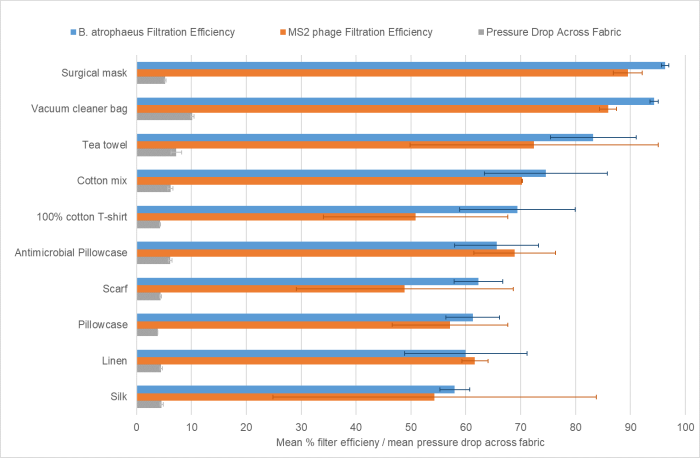You’ll all have seen wide variety of masks and face coverings worn in a wide (and often alarming!) variety of ways. Leaving aside the (in)correct wearing of masks, it’s useful to see some comparative data on the relative respiratory protection offered by different mask materials. This study, published years ago (pre COVID!), does just that.
But first, some background on the various types and categories of masks and face coverings:
- Face coverings – these can be made from any and all materials and don’t offer any certified respiratory protection to the wearer or those around them.
- Surgical masks (aka medical masks) – split into several categories and tested (in Europe) under EN14683:
| Surgical mask | Bacterial filtration efficiency | Breathing resistance (Pa/cm2) | Splash resistance (mmHg) |
| Type I | ≥95% | <29.4 | N/A |
| Type IR | ≥95% | <49.0 | >120 |
| Type II | ≥98% | <29.4 | N/A |
| Type IIR | ≥98% | <49.0 | >120 |
- Face filtering piece (FFP) respirators, tested under EN149 in Europe (see helpful FAQ from the NHS here):
| Respirator | Aerosol filtration | Inward leakage |
| FFP1 | ≥80% | <22% |
| FFP2 | ≥94% | <8% |
| N95 | ≥95% | – |
| FFP3 & N99 | ≥99% | <2% |
In England, healthcare workers need to wear Type IIR surgical masks when in clinical areas, and at the least Type I surgical masks when in hospital buildings. Hospital patients and visitors must wear face coverings. FFP3 (or 2 if FFP3 are not available) are required for some aerosol generating procedures, and the wearer must be fit tested (perhaps even more importantly, a fit-check should be performed each time an FFP respirator is donned). Members of the public need to wear face coverings on public transport, in shops, and in other indoor spaces.
So, to the impact of mask material on filtration capacity. This study tested the filtration capacity and pressure drop across a range of mask materials. They used a nebuilser to general aerosols from Bacillus atrophaeus spores and MS2 phage in the 1-3 µm range. And here’s what they found:
Figure: Filtration efficacy and pressure drop of various mask materials. Error bars represent +/- one standard deviation from the mean.

Unsurprisingly, surgical masks came out best in terms of filtration and didn’t do too badly in terms of pressure drop compared with other materials. Vacuum bags came a close second, although with a large pressure drop. Quite a lot of variability was identified in the other materials, illustrated by a larger standard deviation from the mean in terms of filtration. For a couple of the materials, two layers of fabric were tested too, and did better than a single layer.
In summary, it’s important to be aware of the differences in performance of the various different types and categories of masks and why they are recommended for different applications.